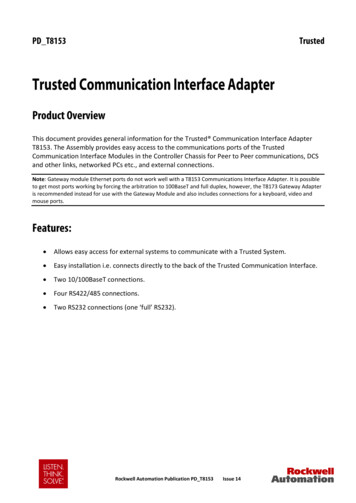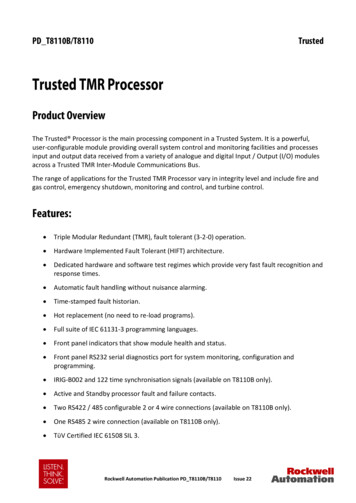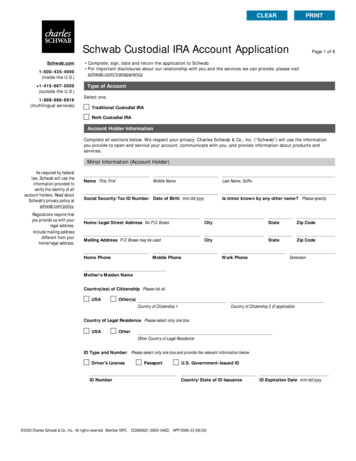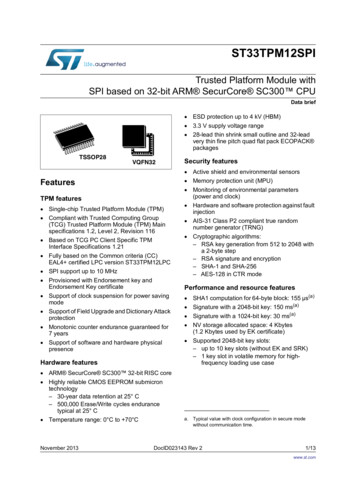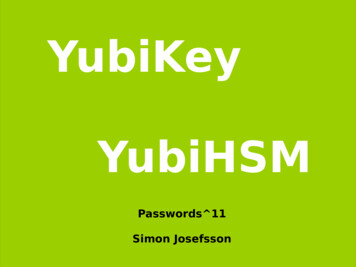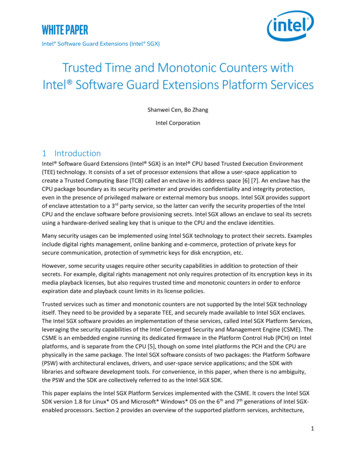
Transcription
White PaperIntel Software Guard Extensions (Intel SGX)Trusted Time and Monotonic Counters withIntel Software Guard Extensions Platform ServicesShanwei Cen, Bo ZhangIntel Corporation1 IntroductionIntel Software Guard Extensions (Intel SGX) is an Intel CPU based Trusted Execution Environment(TEE) technology. It consists of a set of processor extensions that allow a user-space application tocreate a Trusted Computing Base (TCB) called an enclave in its address space [6] [7]. An enclave has theCPU package boundary as its security perimeter and provides confidentiality and integrity protection,even in the presence of privileged malware or external memory bus snoops. Intel SGX provides supportof enclave attestation to a 3rd party service, so the latter can verify the security properties of the IntelCPU and the enclave software before provisioning secrets. Intel SGX allows an enclave to seal its secretsusing a hardware-derived sealing key that is unique to the CPU and the enclave identities.Many security usages can be implemented using Intel SGX technology to protect their secrets. Examplesinclude digital rights management, online banking and e-commerce, protection of private keys forsecure communication, protection of symmetric keys for disk encryption, etc.However, some security usages require other security capabilities in addition to protection of theirsecrets. For example, digital rights management not only requires protection of its encryption keys in itsmedia playback licenses, but also requires trusted time and monotonic counters in order to enforceexpiration date and playback count limits in its license policies.Trusted services such as timer and monotonic counters are not supported by the Intel SGX technologyitself. They need to be provided by a separate TEE, and securely made available to Intel SGX enclaves.The Intel SGX software provides an implementation of these services, called Intel SGX Platform Services,leveraging the security capabilities of the Intel Converged Security and Management Engine (CSME). TheCSME is an embedded engine running its dedicated firmware in the Platform Control Hub (PCH) on Intelplatforms, and is separate from the CPU [5], though on some Intel platforms the PCH and the CPU arephysically in the same package. The Intel SGX software consists of two packages: the Platform Software(PSW) with architectural enclaves, drivers, and user-space service applications; and the SDK withlibraries and software development tools. For convenience, in this paper, when there is no ambiguity,the PSW and the SDK are collectively referred to as the Intel SGX SDK.This paper explains the Intel SGX Platform Services implemented with the CSME. It covers the Intel SGXSDK version 1.8 for Linux* OS and Microsoft* Windows* OS on the 6th and 7th generations of Intel SGXenabled processors. Section 2 provides an overview of the supported platform services, architecture,1
White PaperIntel Software Guard Extensions (Intel SGX)and software / firmware stack. Section 3 introduces the APIs in the Intel SGX SDK for setting up andusing the trusted platform services. Section 4 presents an in-depth discussion on architecture topicsincluding how the components establish their identities and how they verify mutual trust andestablishes secure sessions between them. Finally Section 5 summarizes and wraps up the paper.2 Overview2.1 Trusted Platform ServicesThe trusted platform services implemented by the Intel SGX Platform Services software and madeavailable to application enclaves through the Intel SGX SDK include the following two features: Trusted time – for timer-based policy enforcement on offline platforms that don’t have accessto remote time servers for trusted calendar time.Monotonic counter – for replay protection of offline storage, enforcement of counter-basedpolicies, etc.The Intel SGX Platform Services architecture and the Intel SGX SDK implementation protect the integrityof the platform services, and provide mechanisms for application enclaves to detect in case the integrityof the services is disrupted, for example, when the battery powered real-time clock is reset.2.2 Architecture OverviewFigure 1 shows a high-level architecture diagram of the Intel SGX Platform Services, including the TCBcomponents and the relationship between them.CPUApplication form ServiceEnclave (PSE)SecureChannelConverged Securityand ManagementEngine (CSME)Figure 1 Platform Services Overall ArchitectureThe CSME in the PCH provides a set of security capabilities including battery backed real-time-clock(RTC) and replay-protected storage, and exposes an interface for trusted software running in the CPU tosecurely access these capabilities.On the CPU side, the Platform Service Enclave (PSE) implements the trusted time and monotoniccounter services by leveraging the CSME security capabilities. It enables a large number of applicationenclaves to access the platform services, in spite of limited resources in the CSME.The PSE and the CSME use a key-exchange protocol called SIGMA to pair with each other (to verifymutual trust and establish shared secrets), and to create an ephemeral secure session between them.The SIGMA protocol requires the PSE to be provisioned a certificate of a type called Elliptic Curve DigitalSignature Algorithm (ECDSA), and the CSME to be provisioned a certificate of a scheme called Intel2
White PaperIntel Software Guard Extensions (Intel SGX)Enhanced Privacy ID (EPID). Further discussions on EPID, SIGMA, and PSE – CSME pairing and ephemeralsession establishment are covered later in the architecture deep dive section (Section 4).To access trusted platform services, an Application Enclave (AppEnclave) establishes a secure sessionwith the PSE using an SGX report based key exchange protocol. More details about AppEnclave – PSEsecure session establishment is presented in the architecture deep dive section (Section 4). Typically, anAppEnclave relies on a remote server to provision secrets to it, and needs to attest to the server itssecurity properties. To allow attestation by the remote server of the trust-worthiness of platformservices that the AppEnclave uses, the PSE provides its security information as well as that of the pairedCSME to the AppEnclave, to be forwarded to the remote server for verification.2.3 Software / Firmware StackThe security-oriented architecture diagram in Figure 1 only shows the TCB components involved andtheir relationship. In implementation, each TCB requires support of untrusted software to provide nonsecurity related functionalities and to expose interfaces for interaction with other components. Figure 2shows an implementation-oriented software / firmware stack nAppEnclaveAppEnclaveAppEnclave-PSE MessagesAESMPSE-pr, PSE-opPSE Untrusted CodePSE-CSME MessagesDAL Host Interface ServiceManagement Engine Interface (MEI) DriverCPUDevice read/writeCSME Device InterfacePSE-CSME MessagesPCHPlatform ServiceDAL Applet (PSDA)CSME FirmwareFigure 2 Platform Services Software / Firmware StackThe CSME consists of the embedded CSME hardware engine in the PCH and the firmware running in it.To support flexibility for adding new features without having to modify the firmware image itself, theCSME firmware has a module called the Dynamic Application Loader (DAL). This DAL module allows thehost software to dynamically load and execute a Java applet (called DAL applet) in the CSME at runtime,and to establish a secure session with it. To support flexibility without compromising security, all DALapplets must be signed properly [5].3
White PaperIntel Software Guard Extensions (Intel SGX)For communication between DAL applets and host software, two components in the host software stackare involved: a kernel-space Management Engine Interface (MEI) driver, and a user-space DAL hostinterface service. These components are typically pre-installed along with other Intel software on anIntel platform [5].The Intel SGX Platform Services related features in the CSME are provided by a DAL applet called thePlatform Services DAL Applet (PSDA). The PSDA securely exposes the CSME security capabilitiesincluding battery backed RTC and replay-protected storage to the PSE.A background service process called the Intel SGX Architectural Enclave Service Manager (AESM) hoststhe PSE enclave. During runtime, when the AESM starts, it automatically loads and starts the PSDAapplet. It also reloads the PSDA upon platform events such as resume from standby or hibernation.For modular software development, optimized use of limited Intel SGX resources, and improved securityby reducing complexity of individual enclaves, the PSE is implemented as two separate enclaves: anenclave for provisioning of a PSE certificate and pairing with the CSME (called PSE-pr), and anotherenclave for platform services operations (called PSE-op). These two enclaves are designed so that sealedsecrets can be shared between them, and there is no need to run both enclaves at the same time. TheAESM invokes the PSE-pr for PSE certificate provisioning and PSE – CSME pairing only if a pairingbetween the PSE and the CSME does not exist yet.An application enclave (AppEnclave) is hosted in a user-space application. The enclave and the hostingapplication can use the libraries provided in the Intel SGX SDK to establish secure session with the PSEthrough inter-process communication, to retrieve Intel SGX Platform Services security information, andto access the supported services.3 Programming with Platform Services3.1 Secure Session Establishment between Application Enclave and the PSEBefore an application enclave can access any trusted platform services, it needs to establish a securesession with the PSE. For the session establishment process to be successful, the PSE needs to beprovisioned with a valid certificate, successfully paired with the CSME and established an ephemeralsecure session with the latter. The Intel SGX Platform Services software is designed so that theapplication enclave – PSE secure session establishment flow automatically triggers these pre-requisiteflows if they are not already completed.The Intel SGX SDK provides several API functions in its trusted libraries for application enclaves to createand close secure sessions with the PSE, and retrieve security information for remote attestation. Thefunctions in the trusted libraries of the SDK are intended to be invoked from within an enclave. Thissection provides a brief summary of these functions. More detailed descriptions can be found in [2] and[3]. The functions are: sgx create pse session() – creates a secure session with the PSE.- Upon receiving a request from an application enclave, the PSE checks if the pre-requisiteflows are completed. The AESM initiates these flows automatically if needed.4
White PaperIntel Software Guard Extensions (Intel SGX) sgx close pse session() – closes the existing secure session with the PSE.sgx get pse sec prop() – retrieves security information for the PSE and the pairedCSME (including the PSDA), for remote attestation.- The retrieved security information is returned as an opaque byte-stream, to be interpretedby the remote attestation server3.2 Trusted Time ServiceFor trusted time service, the PSE provides a CSME Protected Real-Time Clock (PRTC) based timer toapplication enclaves. This trusted time service can be used by an application enclave running on anoffline platform (that does not have access to trusted calendar time from a remote time server) to trackthe amount of time passed since a previous read of the timer. Note that the trusted time serviceprovides coarse-grain timer values in units of seconds relative to a reference point. It does not providetrusted calendar (or wall clock) time. An application enclave that requires trusted wall-clock time needsto retrieve it from a trusted remote time server, which is outside of the scope of the Intel SGX SDK.The trusted time service uses an epoch value (called timer source epoch) to enable an applicationenclave to detect if there is discontinuity between different timer reads. A change of the timer sourceepoch value between two reads indicates that either the PRTC in the paired CSME has been reset due toevents like battery replacement, or the PSE has paired with a different CSME due to unexpected eventsuch as software attack. In this case, the application should not trust the calculated duration betweenthe two reads, and handle the error condition properly. More discussion on the architecture for thetrusted time service is presented in the architecture deep dive section (Section 4.6).The Intel SGX SDK provides a trusted library API function, sgx get trusted time(), forapplication enclaves to retrieve the current timer value and the timer source epoch.3.3 Monotonic Counter ServiceThe PSE is capable to simultaneously support multiple monotonic counters for multiple applicationenclaves. Each monotonic counter is assigned a cryptographically unique identifier (called monotoniccounter ID), and includes an access control policy based on the signing key and / or measurement of therequesting application enclave.Internally the PSE maintains a secure database to manage all the active monotonic counters, and usesthe replay-protected storage in the CSME for integrity and replay protection of the database. In case thePSE detects unexpected events – such as loss of pairing with the CSME or corruption of the database –that void the integrity and replay protection of the database, it will re-initialize the database, causing allexisting monotonic counters to be lost. More discussion on the architecture for the monotonic counterservice is presented in the architecture deep dive section (Section 4.7).An application enclave can request the PSE to create a new monotonic counter, increment an existingone, read its value, or delete it. The application enclave should be designed to detect unexpected loss ofa monotonic counter and handle the error condition properly.The Intel SGX SDK provides a set of trusted library API functions for application enclaves to access themonotonic counter service provided by the PSE, as follows:5
White PaperIntel Software Guard Extensions (Intel SGX) sgx create monotonic counter(), sgx create monotonic counter ex() –creates a new monotonic counter with a default initial counter value and returns its ID. Theextended version function allows specification of a custom access control policy.sgx increment monotonic counter() – increments the value of the monotoniccounter with the provided ID.sgx read monotonic counter() – reads the current value of the monotonic counterwith the provided ID.sgx destroy monotonic counter() – deletes the monotonic counter with theprovided ID.3.4 Sample Code - SealedDataTo demonstrate how the Intel SGX Platform Services can be used, the Intel SGX SDK includes a sampleproject called SealedData. This sample project shows how an application can use the monotonic counterand trusted time to enforce policies based on number of uses (called replay protected policy) orexpiration time (called time-based policy). These types of policies are enforced in applications such asdigital rights management (DRM).The sample project includes an enclave and a hosting application. For the replay protected policy, thesample project shows how to initialize, update, and verify a policy, as well as how to detect when thenumber of uses has reached the pre-defined limit, and how to detect when integrity of the policy iscompromised. For the time-based policy, the sample project shows how to initialize and use the policy,and how to detect timer expiration [2] [4].4 Architecture Deep DiveAs discussed in the architecture overview section (Section 2.2), the PSE and the CSME use a SIGMAprotocol to pair with each other, then use their shared pairing secret to establish an ephemeral securesession. The SIGMA protocol requires the PSE to be provisioned an ECDSA certificate, and the CSME tobe provisioned with an EPID certificate. In addition, the application enclave uses the SGX report basedprotocol to establish secure session with the PSE. This section provides an in-depth discussion of thesearchitecture topics.4.1 SGX and CSME Identities for Platform ServicesBefore pairing, the PSE and the CSME are required be provisioned with valid certificates for mutualauthentication. Provisioning of the PSE certificate in turn requires that the Intel SGX platform isprovisioned with an EPID attestation key.The EPID algorithm is an asymmetric key signature scheme that allows a platform to attest to a remoteserver before receiving services from the latter, while preserving its privacy. Many platforms becomemembers of an EPID group. Each member has a unique private key, while the EPID group has a group IDand a single public key. The remote server has the group ID and public key. An entity called the EPIDauthority is responsible for management of EPID groups, public and private key provisioning, andplatform revocation. A platform uses its own private key to sign messages for the remote server. While6
White PaperIntel Software Guard Extensions (Intel SGX)the remote server uses the group public key to verify signed messages, the EPID is designed so that it isnot able to determine which specific private key is used to create the signature [5].The provisioning of an EPID attestation key to an Intel SGX platform is performed by an enclave in theIntel SGX SDK called the Provisioning Enclave (PvE) working with an Intel provisioning server. The PvEdemonstrates to the provisioning server that it runs on an authentic Intel SGX CPU and has an up to dateTCB. Then it joins an EPID group selected by the server, and is provisioned its EPID private key. AfterEPID provisioning, the PvE shares its EPID credential (including the private key, the group ID, and thegroup public key) with another enclave called the Quoting Enclave (QE). An application enclave performsremote attestation to a remote application server using the QE’s EPID signing capability. The QE usesthe SGX report based protocol to verify that the application enclave runs on the same local SGX platformas the QE itself. Then the QE signs the security properties of the application enclave – contained in theapplication enclave’s SGX report – with its EPID private key into a data structure called SGX quote. Theremote application server works with an Intel attestation server to verify the validity of the SGX quote,then verifies the application enclave security information in the signed SGX report. More informationabout Intel SGX EPID provisioning and remote attestation can be found in white paper [9].The CSME is provisioned with its own EPID private key during Intel’s manufacturing process, as well asthe rest of its EPID credential (including the EPID certificate with the group public key) through othermeans, before PSE – CSME pairing is invoked the first time [5].4.2 PSE Certificate Provisioning and PSE – CSME PairingThe PSE and the CSME use a SIGMA protocol to pair with each other. SIGMA is a key exchange protocolbetween two end points, with one called the SIGMA prover and the other the SIGMA verifier. ThisSIGMA protocol requires the prover to be in an EPID group and provisioned with an EPID private key andits EPID certificate, and requires the verifier to be provisioned with an ECDSA certificate. The prover andverifier verify each other’s’ certificates and signatures and use Elliptic Curve Diffie-Hellman (ECDH)algorithm to establish shared session keys between them for secure message exchange [5] [8].In the SIGMA protocol for PSE – CSME pairing, the CSME functions as the SIGMA prover, and the PSEfunctions as the SIGMA verifier.Before pairing with the CSME, the PSE needs to be provisioned with its ECDSA certificate by an Intelserver. In the provisioning flow, the PSE performs SGX remote attestation with the Intel server to provethat it is a PSE instance with up to date TCB running on an authentic Intel SGX platform. Upon successfulattestation, the Intel server signs the ECDSA public key from the PSE into a certificate. Figure 3 depicts ahigh-level view of the PSE certificate provisioning flow.7
White PaperIntel Software Guard Extensions (Intel SGX)1. SGX EPID Group ID2. Signature Revocation List for the EPID groupPSE3. PSE Quote, CSR (with ECDSA public key)IntelServer4. PSE CertificateFigure 3 PSE Certificate Provisioning Flowa. In steps 1 and 2, the PSE sends the SGX EPID group ID to the Intel server, and receives thesignature revocation list for the SGX EPID group.b. In step 3 and 4, the PSE generates an ECDSA private / public key pair, puts the public key in adata structure called Certificate Signing Request (CSR). It then works with the quoting enclave(QE, described in Section 4.1) to sign its SGX report that contains the PSE security properties anda hash of the CSR into an SGX quote. The QE also checks the revocation list the PSE received instep 2 to verify that its EPID private key is not revoked. By inspecting the received SGX quoteand the signed SGX report and CSR, the Intel server verifies the PSE security properties and theCSR integrity, and signs the ECDSA public key in the CSR into a certificate.Upon successful completion of the PSE certificate provisioning flow, the PSE has its ECDSA private keyand a certificate for its ECDSA public key.With the PSE provisioned its ECDSA certificate and the CSME having its EPID credential, they can pairwith each other using the SIGMA protocol, to verify mutual trust and to establish shared pairing secrets.Figure 4 shows a high-level view of the SIGMA based PSE – CSME pairing flow.1. CSME EPID Group ID, CSME ECDH public key ga,OCSP NonceCSME4. PSE cert chain, PSE ECDH public key gb, OSCP responses,CSE EPID signature revocation list, ECDSA signature of (ga gb)2: OCSP Requests3: OCSP ResponsesOCSPResponderPSE5. CSME EPID group cert, EPID signature of (ga gb)Figure 4 PSE – CSME SIGMA-based Pairing Flowa. In step 1, the CSME generates an ECDH private key a and calculates the public key ga. It alsogenerates a nonce for use in OCSP requests (called OCSP nonce). The CSME sends its EPID groupID, its ECDH public key ga, and the OCSP nonce to the PSE.8
White PaperIntel Software Guard Extensions (Intel SGX)b.In steps 2 and 3, the PSE retrieves an OCSP response for every cert in its ECDSA cert chain, usingthe CSME OCSP nonce in its OCSP requests. It verifies the OCSP responses and triggers reprovisioning of its ECDSA cert if its existing cert is revoked.c. In step 4, the PSE finds the signature revocation list for the CSME EPID group, generates itsECDSA key pair (b, gb), derives shared secret gab from its private key b and the CSME public keyga, and signs the two ECDH public keys (ga gb) with its ECDSA private key. From the sharedsecret gab, the PSE uses a Keyed-Hash Message Authentication Code (HMAC) algorithm to deriveshared keys (called SMK, SK, and MK). Finally the PSE sends its ECDSA cert chain, OCSPresponses, its ECDH public key gb, the CSME EPID signature revocation list, and the ECDSAsignature of (ga gb) to the CSME.d. In step 5, the CSME verifies the PSE cert chain and the OCSP responses, verifies the ECDSAsignature of (ga gb) using the public key in the PSE cert, signs (ga gb) using its EPID private keyand the received EPID signature revocation list, and derives the same shared secret SMK, SK,and MK from shared secret gab. Finally the CSME sends its EPID group cert and the EPIDsignature of (ga gb) to the PSE.e. The PSE, upon receiving the message from the CSME in step 5, verifies the received EPID groupcert and the EPID signature of (ga gb).Upon successful completion of the PSE – CSME pairing flow, the PSE and the CSME have verified eachother’s certificates, and are in possession of the same shared secrets SK and MK. They use the SK andMK to derive additional values as their identities (called PSE ID and CSME ID). In addition, the PSEgenerates a nonce, called Pairing-Nonce, to uniquely identify this pairing. The PSE also collects securityinformation of the paired CSME (see Section 4.5 for details). The PSE and the CSME only need toperform pairing for one time. They securely save their pairing secrets in their persistent storage.4.3 PSE – CSME Ephemeral Session EstablishmentWith the PSE – CSME pairing in place, upon startup, the PSE initiates a flow to establish an ephemeralsecure session with the CSME using their shared pairing secrets, as shown in Figure 5.1. Start Session2. CSME ID, Nonce CSMEPSE3. (PSE ID, Nonce PSE, CSME ID, Nonce CSME) protectedby shared MKCSME4. (CSME ID, Nonce CSME) protected by shared MKFigure 5 PSE and CSME Ephemeral Session Establishment Flowa. The PSE and the CSME generate their nonce, Nonce PSE and Nonce CSME respectively.b. In step 2 and 3, the PSE and the CSME exchange their IDs and nonce.9
White PaperIntel Software Guard Extensions (Intel SGX)c. In steps 3 and 4, messages between the PSE and the CSME are integrity-protected by sharedpairing key MK, so the PSE and the CSME can verify the integrity of their exchanged messagesand m the IDs in the messages against their locally-saved pairing secretsUpon successful completion of the PSE – CSME ephemeral session establishment flow, the PSE and theCSME use an HMAC algorithm with their shared pairing key SK and nonce Nonce PSE and Nonce CSMEto derive session specific symmetric keys. The established session only lasts until the PSE stops and isthus called an ephemeral session.4.4 Application Enclave – PSE Secure Session EstablishmentBefore an application enclave (AppEnclave) can use the trusted platform services, it establishes a securesession with the PSE using an SGX report based key exchange protocol. A high-level view of the securesession establishment flow is shown in Figure 6.1. Start Session2. PSE ECDH public key ga, PSE TARGETINFOAppEnclave3. (AppEnlave SGX report, AppEnclave ECDH public key gb)protected by shared key derived from gabPSE4. (PSE SGX report, CSME Security information) protectedby shared key derived from gabFigure 6 Application Enclave - PSE Secure Session Establishment Flowa. The AppEnclave and the PSE generate their ECDH private keys a and b, and calculate theircorresponding public keys ga and gb respectively.b. In steps 2 and 3, they exchange their public keys and calculate their shared ECDH secret gab forintegrity protection of their message exchange in steps 3 and 4.c. In steps 3 and 4, the AppEnclave and the PSE send their SGX reports to each other forverification that both enclaves run on the same SGX platform. The PSE also passes the securityinformation of the paired CSME to the AppEnclave. The AppEnclave retrieves the securityinformation of the PSE from its SGX report.Upon successful completion of the AppEnclave – PSE secure session establishment flow, the AppEnclaveand the PSE use a Cipher-based Message Authentication Code (CMAC) algorithm with their shared ECDHsecret gab to derive session keys for protection of follow-up messages between them. The AppEnclavealso has the security information of the PSE and the paired CSME.4.5 PSE and CSME Security Information for Remote AttestationBefore an application enclave (AppEnclave) can receive secrets such as private keys from a remoteserver, it needs to attest its security properties to the latter. If the enclave uses trusted platformservices, the Intel SGX Platform Services subsystem becomes part of its TCB. As a result, the enclave10
White PaperIntel Software Guard Extensions (Intel SGX)needs to provide the security information of the PSE and its paired CSME to the remote server forattestation.The PSE security information is received in the PSE SGX report as part of the AppEnclave – PSE securesession establishment flow. The information includes PSE product ID, security version number (SVN), thePSE signing key information, and the PSE enclave measurement.The CSME security information is received by the PSE as part of the PSE – CSME pairing flow, andprovided by the PSE to the AppEnclave as part of the AppEnclave – PSE secure session establishmentflow. The CSME security information includes the CSME’s EPID group ID, the version numbers of therevocation lists for the CSME EPID private key and signature, and the identity information and securityversion number of the PSDA.4.6 Trusted Time Service ArchitectureAs discussed in Section 3.2, for trusted time service, the PSE uses the CSME Protected Real-Time Clock(PRTC) based timer, and provides a timer source epoch to allow application enclaves to detect timerdiscontinuity. A high-level view of the architecture for the trusted time service is shown in Figure 7.CPUPCHTimer value,Timer Source EpochAppEnclaveAppEnclaveAppEnclaveTimer value,RTC EpochPSECSMETimervaluePRTCFigure 7 High-level Architecture for Trusted Time ServiceIn the CSME, each time the PRTC is reset (for example, due to battery replacement), it generates a newnonce for its RTC epoch. Each time the PSE reads the RTC timer value from the CSME, the CSME returnsthe current RTC epoch along with the timer value.For each AppEnclave, the PSE derives per-enclave timer source epoch as a hash of the RTC epoch, thePSE – CSME Pairing-Nonce, and the singing key information of the AppEnclave. As a result, differentenclaves have different timer epoch values. Within an enclave, the timer source epoch value changes ifthe PRTC is reset or the PSE – CSME pairing changes.4.7 Monotonic Counter Service Architecture4.7.1 Overall ArchitectureAs discussed in Section 3.3, the PSE maintains a secure database to manage all the monotonic counters,and uses the replay-protected storage (RPS) in the CSME for integrity and replay protection of thedatabase. Since the monotonic counters are implemented in software by the PSE, they are als
Intel Software Guard Extensions (Intel SGX) 2 and software / firmware stack. Section 3 introduces the APIs in the Intel SGX SDK for setting up and using the trusted platform services. Section 4 presents an in-depth discussion on architecture topics including how the components establish their identities and how they verify mutual trust and



